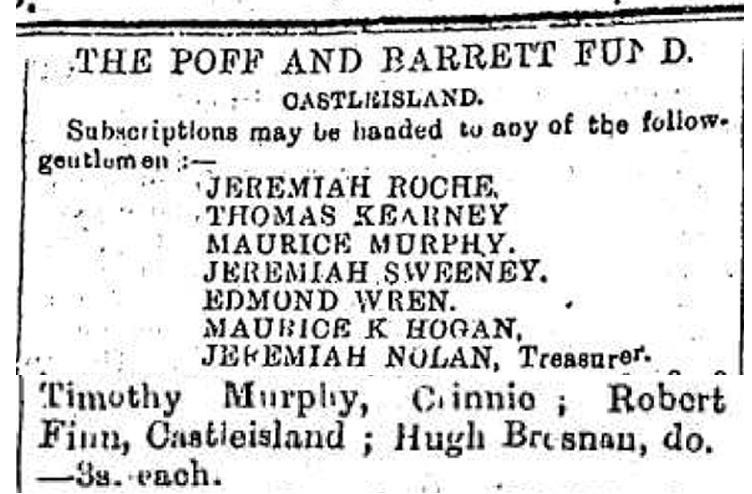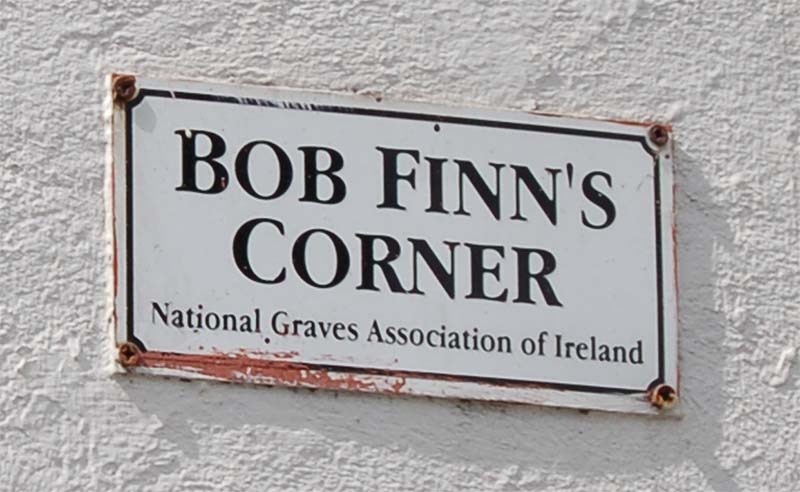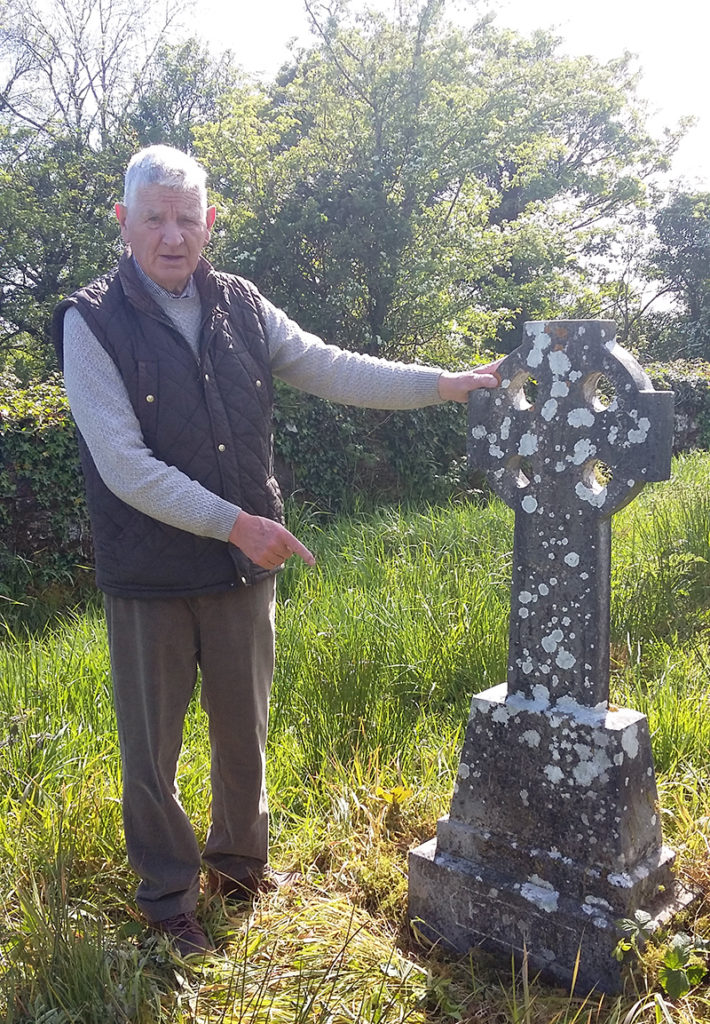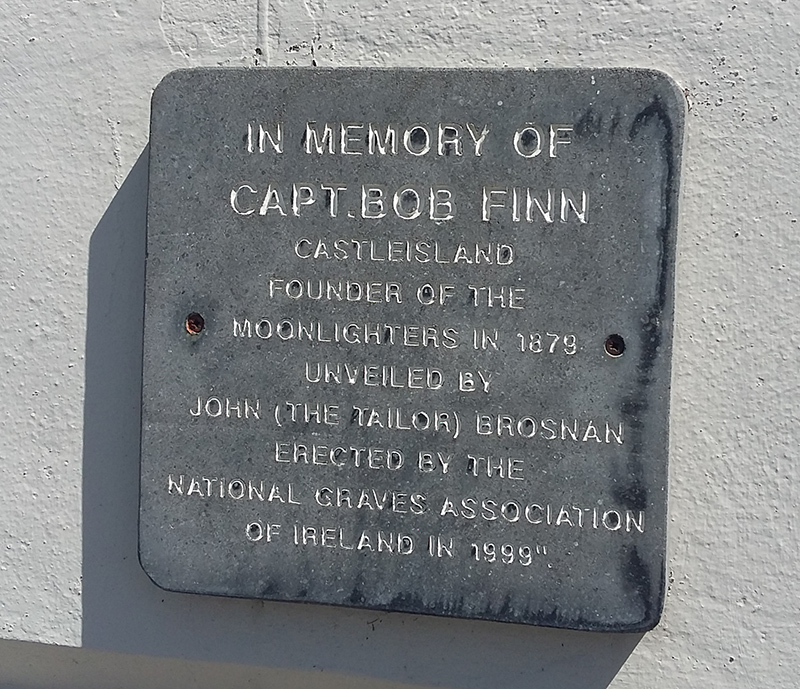Every fool can be a patriot ... every blackguard can sing a national hymn and wave a flag. But it takes a man to live a life of devotion and sacrifice for his country.1
Robert – ‘Bob’ – Finn was born in Castlegregory in 1860, son of William Finn and Sara Casey. The family moved to Castleisland in 1861 where Bob grew into a fit, athletic man, musical, clean living, hardy and fearless. It was said the worries of the world lay lightly on Bob Finn’s shoulders.
He was also an out-and-out Irish Irelander, a fierce opponent of British rule.
In 1879, almost one year before the first Land League meeting was held in Castleisland, the first company of moonlighters was formed:
One evening in 1879, Mr Robert Finn, then a young athlete of great promise, met two Castleisland men of his own age, Mr Batt O’Leary and Mr Justin McCarthy, who asked him to form a secret society for the purpose of freeing Ireland from English rule and to help the farmers to put down land-grabbing.
Bob Finn considered the matter for a few days until the three met again at Cahereens, to the south of the town, when there and then the foundation members of the first company of moonlighters were sworn in and Bob was made Captain of the infant organisation.2

T M Donovan described Finn as ‘a natural born leader’:
But for the bravery and determination of the first Captain Moonlight, Bob Finn, the first company of moonlighters would have been nipped in the bud. The first moonlight raiders were mostly young men of the town – younger brothers and neophytes of the Island company of Fenians with a Protestant Fenian– Henry Williams – as Armourer, a true and well tried Nationalist. 3
Donovan described the young men as ‘more Fenian than agrarian’:
None of them committed a crime that they need be ashamed of even if, technically, they broke the law. They wanted guns, not altogether to free the land from landlordism but to free Ireland from the English. One thing they did for the men on the land – they finally and for good put down land grabbing.
Forster’s Coercion Act dispersed many of the originating class of moonlighters and the movement afterwards passed into other hands – agrarian hands that Donovan claimed ‘knew next to nothing of Fenianism.’4
Donovan believed that Bob Finn’s company was the first to take the field in Ireland and as such held claim as the original Captain Moonlight. Donovan wrote:
Many captain moonlights afterwards sprang up in almost every county in Ireland but the first was the Castleisland captain who with his band met in secret ‘in the old spot by the river’ to fight English misrule and Irish landlordism.5
‘They went out to do good and not evil’
Their services to the national cause were not for financial gain. Personal gain was irrelevant – it was simply for love of country. Their training 140 years ago is revealed in the following anecdote:
The men were marching on the road near Castleisland. It was the first time that many of them ever handled a gun. They were without drill, or training, or discipline. Suddenly, out from a crossroads, came a squad of four policemen armed with rifles and revolvers. A bloody encounter seemed imminent. Some of the boys visibly weakened and for a minute or two, it looked as if a few would bolt. Then the captain’s voice rang out clear and resolute: ‘The first man that leaves the ranks I will shoot him dead.’ They knew he would.
Captain Moonlight gave the first deadly stroke to Irish landlordism. His band succeeded in doing away with the chief prop of the rack-renting landlords – the grabber, or rural ‘blackleg’. Being more Fenian than agrarian, they would consider themselves eternally disgraced if any of their number was proved guilty of the crimes that were subsequently perpetuated – with growing violence – by a succeeding class:
The succeeding moonlighters were of a different class in the towns with a small number of farm labourers. They committed every form of outrage when the original moonlighters were either imprisoned or exiled by Forster’s Coercion Act. Their argument was that their crimes at their worst were only as dust in the scales that weighed against the age-long crimes of a ruthless landlord.6
Forster’s Act drove those who escaped imprisonment (without trial) to America and Australia. Bob Finn numbered among those who fled to Australia; he returned to Castleisland from Sydney after about one year.7 He was back in Castleisland when he contributed to the Poff and Barrett fund in 1883.

In subsequent years, he captained the Castleisland Desmonds football team and became club treasurer and representative at County Board level. He also married in July 1888 to Margaret, daughter of Maurice Reidy and Catherine Fleming.
Bob Finn was by trade a cooper, his workshop located in Church Street on the site now occupied by Castleisland Motor Factors. He inherited from his father-in-law a public house in Main Street and was known for taking up his fiddle and providing musical entertainment in the bar.

In 1915, Bob Finn was summonsed for a breach of the licensing laws. The temper of the times is almost palpable in the investigation that followed the entry of Sergeant Watson and Constable Mc Donagh to Mr Finn’s licensed premises at 3.10pm one Sunday. They arrived by the door leading to Chapel Street and found the publican sitting at the kitchen fire with Patrick O’Reilly and John Daly. On the table near them were ‘two medium glasses full of stout’ and ‘a pony of stout on the mantelpiece’.8
Bob and Margaret Finn had three sons, William (b1889), Maurice (b1891) and Michael (b1895) and two daughters, Sarah (b1893) and Kathleen (b1899). The death of Mrs Margaret Finn on 18 June 1905 left her husband distraught.
Of Bob Finn’s sons, only record of Maurice can be found. He seems to have lived in England and remained single. He died on 1 August 1940 in Southampton Hospital. Sarah Finn, who worked as a barmaid, died in a London hotel in 1928.9
Kathleen Finn married Denis Valentine Haniver, a civil servant, whose father William worked as a railway engine driver, in all probability on the Castleisland railway. Kathleen and Denis married in Tralee in 1922 but seem to have lived in Dublin. They had four children. 10 Kathleen Haniver died in Dublin on 19 November 1974.
Bob Finn died at his corner-house home on 6 August 1935. He was buried in Old Kilbannivane, Castleisland.

A few small engravings in the town preserve the memory of Bob Finn. The corner of Church Street/Main Street is marked by a sign, ‘Bob Finn’s Corner’, as illustrated above. A small plaque on the outside wall of the Carnegie Building was unveiled twenty years ago.11

________
1 Kerry News, 25 September 1916. Quote by Castleisland teacher and author, T M Donovan (c1865-1950), in a discussion about patriotism and the First World War. 2 A Popular History of East Kerry (1931), p89. Donovan named the first company sworn in as Captain Bob Finn, Batt O’Leary, Justin McCarthy (foundation members), Ned Shanahan, Jack Deenihan, Mike Cotter and Bryan O’Connor (Churchtown); Tim and Mike McCarthy, James Hussey, Maurice (Jack) Brosnan, Ned Barry and Con Casey – all of the New Line (now Church Street); Billy Hickey, Jack Flynn, Mundie D O’Sullivan of Close; Ned Healy, Denny Shanahan and Jack Brosnan (New Line) joined up later. A photograph of Bob Finn appears in this publication (opp p96) taken by Mr Healy of Tralee. An image of Bob Finn addressing a meeting in 1905 is held in IE MOD/29/29.4/29.4.6. 3 The Liberator, 2 May 1925. ‘He lived nearly opposite my old home in the New Line and I remember well the commotion that was heard and the emotion that was felt in the New Line the night the peelers arrested him under buckshot Forster’s Act and imprisoned him in Kilmainham.’ An image of Henry Williams appears opposite p64 of Donovan’s Popular History of East Kerry. 4 The Liberator, 2 May 1925. ‘I don’t believe that there is any justification before God for going behind a hedge and shooting a man in cold blood. No cause whatever can justify such a deed. As for the terrible orgy of petty larcenies and daylight robberies that followed in the wake of Captain Moonlight – well such a shameful chapter in our history is better unpenned and forgotten.' 5 Kerry News, 25 September 1916. 6 Kerry News, 25 September 1916. 7 Bob Finn’s younger brother, a Fenian, had to escape a similar danger. Further reference, ‘Moonlighting in Kerry’, The Liberator, 8 December 1936. 8 The case was dismissed. Further reference, The Liberator, 13 February 1915. 9 ‘At the adjourned inquest yesterday at St Pancras, London, on Sarah Finn (34) a native of Castleisland, Co Kerry, who was found dead in the kitchen of a London hotel where she was employed as a barmaid, the coroner said the medical evidence showed that worry had led to the unhinging of the young woman’s mind. He recorded a verdict of ‘suicide while of unsound mind’.’ (Irish Independent, 14 March 1928). 10 ‘Denis Hannever died recently in Dublin. To his wife (nee Finn) also a native of Castleisland, sympathy is extended’ (Kerry Champion, 31 May 1948). Denis died on 20 April 1948. As far as can be established, there were two sons and two daughters, Geraldine and Vera. My thanks to Marie Huxtable Wilson for genealogical detail. 11 The plaque was erected by the National Graves Association of Ireland and unveiled by John ‘The Tailor’ (An Tailiur) P Brosnan, historian, Mount, Scartaglin, in December 1999.


